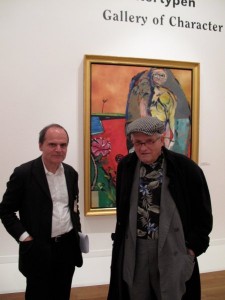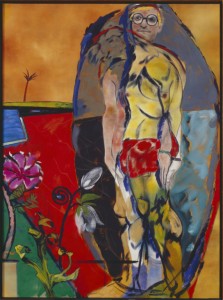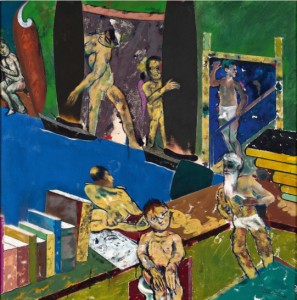On the 19th of October, just past 8 pm, I received the message “David is breaking away from his installation in Köln and will arrive at the Jewish Museum on Sunday 21st. between 11. – 11.30 am.”
Some time before, I had contacted the gallerist Peter Goulds to ask whether David Hockney might be interested in coming to Berlin to visit the R.B. Kitaj exhibition; I knew Hockney would be in Cologne to open his own exhibit “A Bigger Picture” at the Museum Ludwig. Though it seemed unlikely at first, Hockney was able to come. He brought his partner, his studio manager, and a chauffer, and appeared wearing an elegant grey double-breasted suit, a black Hawaii shirt with fantastic plants on it and a checked flat cap.
David Hockney is Kitaj’s oldest painter friend. They met in 1959, on their first day of classes at the London Royal College of Art. Hockney described his impressions upon meeting Kitaj: “I was 22 and he was 27. I was a little provincial from Bradford never been abroad and he sailed the seven seas you know, came from New York, and has seen the world, I haven’t. He was much more sophisticated and I saw he drew very well. We had two things in common, we liked to draw and we liked to read.”
The paths of the two crossed several times, in Paris, London and Los Angeles. Hockney introduced Kitaj to the latter’s second wife, the American painter Sandra Fisher. Together, they travelled to Warsaw and Krakow. Hockney posed naked for Kitaj – and only for him – in front of a white canvas, wearing nothing but two unmatched socks. The result is hanging in the exhibition and goes by the title “The Neo Cubist.” Hockney was particularly pleased to see the painting again.
Hockney discovered a picture of himself in the painting “England Bathers” (1982), wearing his iconic glasses with the overly-large round frames and sitting on the toilet. He laughed. Kitaj described the scene in his memoirs: “Hockney was just coming out of the closet and so I said paint that, so he did and the rest is art history and gay art history too. He switched to his gay culture as I began on my Jewish culture in its first forms.”
 After he left, Hockney thanked me for the tour through the exhibit and wrote: “John, JP and myself were very moved by it, but we did know him, Dominic (younger) had a much harder time with the pictures, he felt you had to know too much, there was a ‘barrier’ for him. We all see differently, even on flat surfaces.”
After he left, Hockney thanked me for the tour through the exhibit and wrote: “John, JP and myself were very moved by it, but we did know him, Dominic (younger) had a much harder time with the pictures, he felt you had to know too much, there was a ‘barrier’ for him. We all see differently, even on flat surfaces.”
A wonderfully democratic statement on art and its reception.
Eckhart J. Gillen, Curator of the exhibition R.B. Kitaj (1932–2007) – Obsessions

